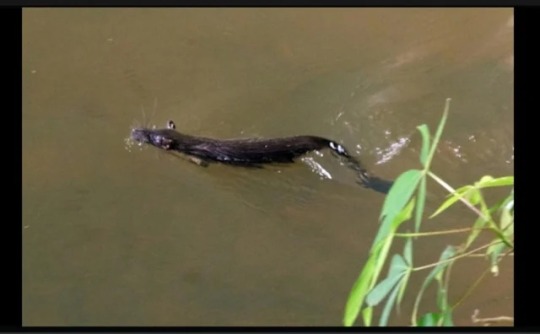#tenrecomorpha
Explore tagged Tumblr posts
Note
can I request the lesser Madagascar hedgehog tenrec? I love them very much
Of course!


#madagascar#madagascar wildlife#tenrec#lesser hedgehog tenrec#mammalia#mammals#mammal#tenrecidae#tenrecomorpha#afrosoricida#animal polls#poll blog#my polls#animals#polls#tumblr polls
44 notes
·
View notes
Text

#Echinops telfairi#lesser hedgehog tenrec#tenrec#mammal#nature#creative commons#animal#wildlife#Tenrecidae#Tenrecomorpha#Afrosoricida#Mammalia#Chordata#madagascar
10 notes
·
View notes
Note




Giant otter shrew
Potamogale velox
Genus Potamogale, subfamily Potamogalinae, family Tenrecidae, suborder Tenrecomorpha
Despite their names, they are neither otters nor shrews. They are afrotherians like elephants, hyraxes, aardvarks, and manatees.
They live here:

They are nocturnal and can not survive in captivity. Most photos online of them are recently deceased or taxidermied because of this.
They don’t have webbed feet, so they swim side to side like crocodilians or fish. Their hind legs have skin flaps along the inside that let them be held close to the body while swimming
Wait can you elaborate on that last part what do the skin flaps do?? Ho w wo oh ok Neve round I think I get it is it like how the fuckin the wheels on the airplane go into the plane when they’re in the air?? Like that? Bro that’s so funny
But man that’s really cool do u have sources for the illustrated pics? I wanna look attm
9 notes
·
View notes
Text
Los tenrécidos (Tenrecidae), conocidos vulgarmente como tenrecs, son una familia de mamíferos placentarios omnívoros del orden Afrosoricida (también conocido como Tenrecomorpha), caracterizados por su pequeño tamaño y por tener un hocico más o menos largo y apuntado que utilizan para desenterrar gusanos e insectos del suelo. Hay unas treinta especies de tenrecs, y viven principalmente en Madagascar, con algunas especies en África y en las islas Comores donde han sido introducidos. La mayoría tienen costumbres nocturnas y habitan en madrigueras excavadas por ellos mismos. Los jóvenes tenrecs maman de la madre durante tres semanas, después de las cuales ya son capaces de seguirla y empezar a alimentarse solos. Esta ilustración es parte de la serie que desarrollo para @lifers_earth y la trabajé en 2020.
#Biodiversidad #Biodiversity #Tenrec #Tenrecomorpha #MaximusEntropy #Drawing #DigitalPainting #Artwork #Illustration #Art #Science #2dart #Scientificillustration #WildLife #mammals #Tenrecidae #WildLifeIllustration #Colombia #Medellín #instaart #artistsofig #Madagascar #artgallery #artist #zoology #biology #africa #comoresisland #Lifers_earth
instagram
#maximusentropy#art#artwork#drawing#digitalpainting#artgallery#instaart#artist#illustration#science#Instagram
1 note
·
View note
Photo

Island Weirdness #23 -- The Bibymalagasy
One of the most mysterious members of Madagascar’s pre-human ecosystem was a creature known as Plesiorycteropus, or the “bibymalagasy”.
It’s known only from fragmentary remains, including a few limb bones, vertebrae, partial skulls, and partial pelvises -- with two different species identified, the larger Plesiorycteropus madagascariensis and the smaller Plesiorycteropus germainepetterae. For a long time it was it was unclear what type of mammal it even was and the best guess seemed to be “some sort of small aardvark-relative” based on anatomical similarities, but various studies disagreed and some even considered it to represent a completely unique order of mammals.
In 2013 an analysis of preserved collagen from one bone finally gave a better answer -- Plesiorycteropus was most closely related to tenrecs, which arrived in Madagascar via ocean rafting during the mid-Cenozoic, and the skeletal resemblance to aardvarks was due to convergent evolution.
It was built for scratch-digging, using its strong forelimbs and claws to dig while bracing itself with its hindlimbs and long thick tail. Its snout had large nasal cavities, indicating a good sense of smell, and similarities to the skulls of armadillos suggest it had the same sort of diet of insects, grubs, worms, and other soft foods. It may also have fed on ants and termites.
Since it’s only known from fragments its full size is hard to determine, but rough estimates suggest Plesiorycteropus madagascariensis was “small dog-sized” -- possibly having a head-and-body length of 60-80cm (2′-2′7), and a total length of over 1m (3′3″).
Unlike some other extinct Malagasy animals there are no historical or folkloric accounts of anything resembling the bibymalagasy. One bone has been carbon dated to just over 2000 years ago, shortly after the arrival of human settlers, and it seems to have gone extinct very soon after that date.

#island weirdness 2019#science illustration#paleontology#paleoart#palaeoblr#plesiorycteropus#bibymalagasy#tenrecomorpha#afrosoricida#afrotheria#mammal#art#madagascar#holocene extinction#oh it's from Madagascar of course it's weird#island weirdness part 1
149 notes
·
View notes
Text
I'm pretty sure this is a lowland streaked tenrec Hemicentetes semispinosus. Although tenrecs are superficially similar to hedgehogs and shrews they're actually more closely related to elephants!
Everyone please. Please look at this animal. It’s called a tenrec and they live in Madagascar and lOOK AT IT!!!!!!! He’s just a little guy! A creachure!!!!!
#lowland streaked tenrec#animals#mammals#tenrecs#s o: afrotheria#o: afrosoricida#s o: tenrecomorpha#f: tenrecidae#s f: tenrecinae#g: hemicenteles#sp: h. semispinosus#tiktok
28K notes
·
View notes